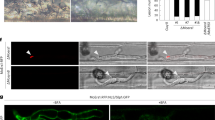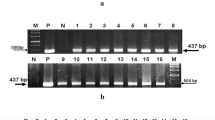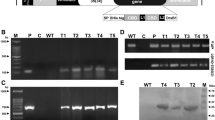Abstract
Blast disease caused by Magnaporthe oryzae is a major contributor to decreased crop yield and rice production globally. The use of chemical fungicides to combat crop pathogens is not only unsafe but also promotes the emergence of pathogenic variants, leading to recurrent host infections. To address plant diseases, antimicrobial peptides have emerged as a promising alternative as they are effective, safe, and biodegradable antifungal agents. This study examines the antifungal activity and mechanism of action of the human salivary peptide histatin 5 (Hst5) on M. oryzae. Hst5 causes morphogenetic defects in the fungus, including non-uniform chitin distribution on the fungal cell wall and septa, deformed hyphal branching, and cell lysis. Importantly, a pore-forming mechanism of Hst5 in M. oryzae was ruled out. Furthermore, the interaction of Hst5 with the M. oryzae genomic DNA suggests that the peptide may also influence gene expression in the blast fungus. In addition to its effects on morphogenetic defects and cell lysis, Hst5 also inhibits conidial germination, appressorium formation, and the appearance of blast lesions on rice leaves. The elucidated multi-target antifungal mechanism of Hst5 in M. oryzae provides an environmentally friendly alternative to combating blast infections in rice by preventing fungal pathogenicity. The promising antifungal characteristics of the AMP peptide may also be explored for other crop pathogens, making it a potential biofungicide for the future.







Similar content being viewed by others
Data availability
Not applicable.
References
Bechinger B, Gorr SU (2017) Antimicrobial peptides: mechanisms of action and resistance. J Dent Res 96(3):254–260. https://doi.org/10.1177/0022034516679973
Bommarius B, Jenssen H, Elliott M, Kindrachuk J, Pasupuleti M, Gieren H et al (2010) Cost-effective expression and purification of antimicrobial and host defense peptides in Escherichia coli. Peptides 31(11):1957–1965. https://doi.org/10.1016/j.peptides.2010.08.008
Brand A, Gow NA (2009) Mechanisms of hypha orientation of fungi. Curr Opin Microbiol 12(4):350–357. https://doi.org/10.1016/j.mib.2009.05.007
Brogden KA (2005) Antimicrobial peptides: pore formers or metabolic inhibitors in bacteria? Nat Rev Microbiol 3(3):238–250. https://doi.org/10.1038/nrmicro1098
Chadha S, Gopalakrishna T (2005) Genetic diversity of Indian isolates of rice blast pathogen (Magnaporthe grisea) using molecular markers. Curr Sci 88:1466–1469
Chadha S, Kale SP (2015) Simple fluorescence-based high throughput cell viability assay for filamentous fungi. Lett Appl Microbiol 61(3):238–244. https://doi.org/10.1111/lam.12460
Chadha S, Sharma M (2014) Transposable elements as stress adaptive capacitors induce genomic instability in fungal pathogen Magnaporthe oryzae. PLoS ONE 9(4):e94415. https://doi.org/10.1371/journal.pone.0094415
Cho J, Lee DG (2011) Oxidative stress by antimicrobial peptide pleurocidin triggers apoptosis in Candida albicans. Biochimie 93:1873–1879. https://doi.org/10.1016/j.biochi.2011.07.011
Ciociola T, Giovati L, Conti S, Magliani W, Santinoli C, Polonelli L (2016) Natural and synthetic peptides with antifungal activity. Future Med Chem 8:1413–1433. https://doi.org/10.4155/fmc-2016-0035
Clinical and Laboratory Standards Institute (2008) Reference method for both dilution susceptibility testing of filamentous fungi, 2nd edn. Clinical and Laboratory Standards Institute, Wayne, PA
Colombo M, Masiero S, Rosa S, Caporali E, Chiara SLT et al (2020) NoPv1: a synthetic antimicrobial peptide aptamer targeting the causal agents of grapevine downy mildew and potato late blight. Sci Rep 10:17574. https://doi.org/10.1038/s41598-020-73027-x
Das K, Datta K, Sarkar SN, Datta SK (2021) Expression of antimicrobial peptide snakin-1 confers effective protection in rice against sheath blight pathogen, Rhizoctonia solani. Plant Biotechnol Rep 15:39–54. https://doi.org/10.1007/s11816-020-00652-3
De Coninck B, Cammue BPA, Thevissen K (2013) Modes of antifungal action and in planta functions of plant defensins and defensin-like peptides. Fungal Biol Rev 26(4):109–120. https://doi.org/10.1016/j.fbr.2012.10.002
Dean R, Van Kan JA, Pretorius ZA, Hammond-Kosack KE, Di Pietro A, Spanu PD et al (2012) The top 10 fungal pathogens in molecular plant pathology. Mol Plant Pathol 13:414–430. https://doi.org/10.1111/j.1364-3703.2011.00783.x
Dennison SR, Mura M, Harris F, Morton LHG, Zvelindovsky A, Phoenix DA (2015) The role of C-terminal amidation in the membrane interactions of the anionic antimicrobial peptide, maximin H5. Biochim Biophys Acta 1848:1111–1118. https://doi.org/10.1016/j.bbamem.2015.01.014
Dixon KP, Xu JR, Smirnoff N, Talbot NJ (1999) Independent signaling pathways regulate cellular turgor during hyperosmotic stress and appressorium-mediated plant infection by Magnaporthe grisea. Plant Cell 11:2045–2058. https://doi.org/10.1105/tpc.11.10.2045
Du H, Puri S, McCall A, Norris HL, Russo T, Edgerton M (2017) Human salivary protein histatin 5 has potent bactericidal activity against ESKAPE pathogens. Front Cell Infect Microbiol 7:41. https://doi.org/10.3389/fcimb.2017.00041
El-Baky NA, Amara AAAF (2021) Recent approaches towards control of fungal diseases in plants: an updated review. J Fungi 7:900. https://doi.org/10.3390/jof7110900
Fernandez J, Orth K (2018) Rise of a cereal killer: the biology of Magnaporthe oryzae biotrophic growth. Trends Microbiol 26:582–597. https://doi.org/10.1016/j.tim.2017.12.007
Fisher MC, Alastruey-Izquierdo A, Berman J, Bicanic T, Bignell EM, Bowyer P et al (2022) Tackling the emerging threat of antifungal resistance to human health. Nat Rev Microbiol 20(9):557–571. https://doi.org/10.1038/s41579-022-00720-1
Gitelson AA, Kaufman YJ, Stark R, Rundquist D (2002) Novel algorithms for remote estimation of vegetation fraction. Remote Sens Environ 80:76–87. https://doi.org/10.1016/S0034-4257(01)00289-9
Gow NA, Brown AJ, Odds FC (2002) Fungal morphogenesis and host invasion. Curr Opin Microbiol 5:366–371. https://doi.org/10.1016/s1369-5274(02)00338-7
Guaní-Guerra E, Santos-Mendoza T, Lugo-Reyes SO, Terán LM (2010) Antimicrobial peptides: general overview and clinical implications in human health and disease. Clin Immunol 135:1–11. https://doi.org/10.1016/j.clim.2009.12.004
Helmerhorst EJ, Reijnders IM, Van’t Hof W, Veerman EC, Nieuw Amerongen AV (1999) A critical comparison of the hemolytic and fungicidal activities of cationic antimicrobial peptides. FEBS Lett 23:105–110. https://doi.org/10.1016/s0014-5793(99)00411-1
Howard RJ, Valent B (1996) Breaking and entering: host penetration by the fungal rice blast pathogen Magnaporthe grisea. Ann Rev Microbiol 50:491–512. https://doi.org/10.1146/annurev.micro.50.1.491
Huo L, Zhang K, Peng LJ, Z, Huang X, Liu H, et al (2011) Antimicrobial and DNA-binding activities of the peptide fragments of human lactoferrin and histatin 5 against Streptococcus mutans. Arch Oral Biol 56(9):869–876. https://doi.org/10.1016/j.archoralbio.2011.02.004
Imamura T, Yasuda M, Kusano H, Nakashita H, Ohno Y, Kamakura T et al (2010) Acquired resistance to the rice blast in transgenic rice accumulating the antimicrobial peptide thanatin. Transgenic Res 19:415–424. https://doi.org/10.1007/s11248-009-9320-x
Iqbal A, Khan RS, Shehryar K, Imran A, Ali F et al (2019) Antimicrobial peptides as effective tools for enhanced disease resistance in plants. Plant Cell Tiss Organ Cult 139:1–15. https://doi.org/10.1007/s11240-019-01668-6
Jia Y, Valent B, Lee FN (2003) Determination of host responses to Magnaporthe grisea on detached rice leaves using a spot inoculation method. Plant Dis 87:129–133. https://doi.org/10.1094/PDIS.2003.87.2.129
Kumamoto CA (2008) Molecular mechanisms of mechanosensing and their roles in fungal contact sensing. Nat Rev Microbiol 6:667–673. https://doi.org/10.1038/nrmicro1960
Kumar R, Chadha S, Saraswat D, Bajwa JS, Li RA, Conti HR et al (2011) Histatin 5 uptake by Candida albicans utilizes polyamine transporters Dur3 and Dur31 proteins. J Biol Chem 286(51):43748–43758. https://doi.org/10.1074/jbc.M111.311175
Lombardi L, Maisetta G, Batoni G, Tavanti A (2015) Insights into the antimicrobial properties of hepcidins: advantages and drawbacks as potential therapeutic agents. Molecules 20(4):6319–6341. https://doi.org/10.3390/molecules20046319
Louhaichi M, Borman MM, Johnson DE (2001) Spatially located platform and aerial photography for documentation of grazing impacts on wheat. Geocarto Int 16:65–70. https://doi.org/10.1080/10106040108542184
Mirzaee M, Holásková E, Mičúchová A, Kopečný DJ, Osmani Z, Frébort I (2021) Long-lasting stable expression of human LL-37 antimicrobial peptide in transgenic barley plants. Antibiotics (basel, Switzerland) 10(8):898. https://doi.org/10.3390/antibiotics10080898
Mochon AB, Liu H (2008) The antimicrobial peptide histatin-5 causes a spatially restricted disruption on the Candida albicans surface, allowing rapid entry of the peptide into the cytoplasm. PLoS Pathog 4:e1000190. https://doi.org/10.1371/journal.ppat.1000190
Muñoz A, López-García B, Marcos JF (2006) Studies on the mode of action of the antifungal hexapeptide PAF26. Antimicrob Agents Chemother 50(11):3847–3855. https://doi.org/10.1128/AAC.00650-06
Muñoz A, López-García B, Pérez-Payá E, Marcos JF (2007) Antimicrobial properties of derivatives of the cationic tryptophan-rich hexapeptide PAF26. Biochem Biophys Res Commun 354(1):172–177. https://doi.org/10.1016/j.bbrc.2006.12.173
Park CB, Kim HS, Kim SC (1998) Mechanism of action of the antimicrobial peptide buforin II: buforin II kills microorganisms by penetrating the cell membrane and inhibiting cellular functions. Biochem Biophys Res Commun 244:253–257. https://doi.org/10.1006/bbrc.1998.8159
Peng Y, Li SJ, Yan J, Tang Y, Cheng JP, Gao AJ et al (2021) Research progress on phytopathogenic fungi and their role as biocontrol agents. Front Microbiol 12:670135. https://doi.org/10.3389/fmicb.2021.670135
Puri S, Edgerton M (2014) How does it kill?: understanding the candidacidal mechanism of salivary histatin 5. Eukaryot Cell 13:958–964. https://doi.org/10.1128/EC.00095-14
Rebollar A, López-García B (2013) PAF104, a synthetic peptide to control rice blast disease by blocking appressorium formation in Magnaporthe oryzae. Mol Plant Microbe Interact 26(12):1407–1416. https://doi.org/10.1094/MPMI-04-13-0110-R
Rivero M, Furman N, Mencacci N, Picca P, Toum L, Lentz E et al (2012) Stacking of antimicrobial genes in potato transgenic plants confers increased resistance to bacterial and fungal pathogens. J Biotechnol 157(2):334–343. https://doi.org/10.1016/j.jbiotec.2011.11.005
Savary S, Willocquet L, Pethybridge SJ, Esker P, McRoberts N, Nelson A (2019) The global burden of pathogens and pests on major food crops. Nat Ecol Evol 3:430–439. https://doi.org/10.1038/s41559-018-0793-y
Spohn R, Daruka L, Lázár V, Martins A, Vidovics F, Grézal G et al (2019) Integrated evolutionary analysis reveals antimicrobial peptides with limited resistance. Nat Commun 10:4538. https://doi.org/10.1038/s41467-019-12364-6
Talbot NJ (2003) On the trail of a cereal killer: exploring the biology of Magnaporthe grisea. Annu Rev Microbiol 57:177–202. https://doi.org/10.1146/annurev.micro.57.030502.090957
Tucker CJ (1979) Red and photographic infrared linear combinations for monitoring vegetation. Remote Sens Environ 8:127–150. https://doi.org/10.1016/0034-4257(79)90013-0
Tucker SL, Talbot NJ (2001) Surface attachment and pre-penetration stage development by plant pathogenic fungi. Annu Rev Phytopathol 39:385–417. https://doi.org/10.1146/annurev.phyto.39.1.385
Wang K, Dang W, Xie J, Zhu R, Sun MG, Jia F et al (2015) Antimicrobial peptide protonectin disturbs the membrane integrity and induces ROS production in yeast cells. Biochem Biophy Acta 1848:2365–2373. https://doi.org/10.1016/j.bbamem.2015.07.008
Wilson RA, Talbot NJ (2009) Under pressure: investigating the biology of plant infection by Magnaporthe oryzae. Nat Rev Microbiol 7:185–195. https://doi.org/10.1038/nrmicro2032
Yan J, Wang K, Dang W, Chen R, Xie J et al (2013) Two hits are better than one: membrane-active and DNA binding-related double-action mechanism of NK-18, a novel antimicrobial peptide derived from mammalian NK-lysin. Antimicrob Agents Chemother 57:220–228. https://doi.org/10.1128/AAC.01619-12
Zhu M, Liu P, Niu Z (2017) A perspective on general direction and challenges facing antimicrobial peptides. Chin Chem Lett 28(4):703–708. https://doi.org/10.1016/j.cclet.2016.10.001
Acknowledgements
The author thanks A. B. Misal, Namrata Ghag, Kranti Nikalje and Liviya Gaikward for assisting in rice pathogenicity, microscopy, calcein leakage and DNA-binding experiments, respectively.
Funding
The authors have not disclosed any funding.
Author information
Authors and Affiliations
Contributions
The work was designed and performed by SC. Manuscript, all figures and table were prepaed by SC.
Corresponding author
Ethics declarations
Conflict of interest
The author declares that the research was conducted in the absence of any commercial or financial relationships that could be construed as a potential conflict of interest.
Additional information
Publisher's Note
Springer Nature remains neutral with regard to jurisdictional claims in published maps and institutional affiliations.
Rights and permissions
Springer Nature or its licensor (e.g. a society or other partner) holds exclusive rights to this article under a publishing agreement with the author(s) or other rightsholder(s); author self-archiving of the accepted manuscript version of this article is solely governed by the terms of such publishing agreement and applicable law.
About this article
Cite this article
Chadha, S. Combating fungal phytopathogens with human salivary antimicrobial peptide histatin 5 through a multi-target mechanism. World J Microbiol Biotechnol 39, 215 (2023). https://doi.org/10.1007/s11274-023-03667-4
Received:
Accepted:
Published:
DOI: https://doi.org/10.1007/s11274-023-03667-4




